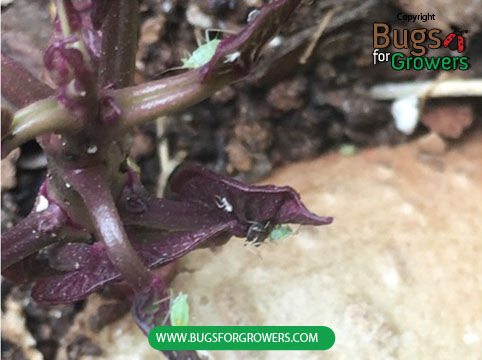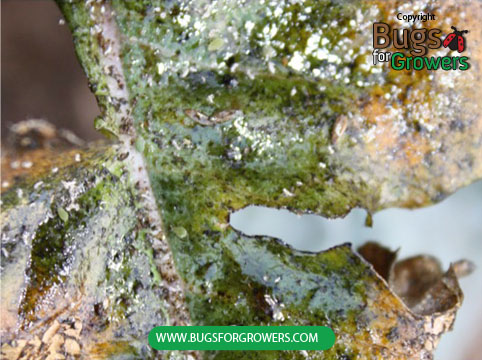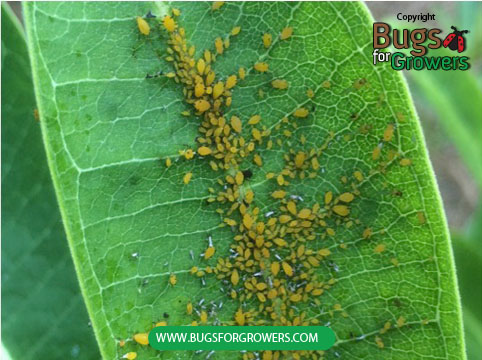Damage caused by aphids
Watch following YouTube video about biological control of aphids with parasitic wasps.
Aphids are small soft bodied insects (Photo 1) that cause feeding damage to different types of ornamentals (roses, crape myrtle etc), crops (potato, sweet potato, cotton, soybean, peanuts, corn, vegetables and fruits etc), weeds and grasses that are grown in the greenhouses, hoop houses, fields and recreational parks.

There are over 4000 species of aphids that exist in nature and known to cause direct and indirect damages to their host plants. For example, both adults and young aphids (nymphs) directly suck cell sap (juice) from all the tender plant parts including buds, flowers, stems, shoots and leaves (Photo 1) of host plants using their piercing and sucking types of mouthparts.
The symptoms of direct feeding damage include yellowing and curling of infested leaves (Photo 2), weak plant growth and reduced the crop yields.

In case of indirect damage, honeydew secreted by aphids during feeding stimulates the growth of black sooty mold on the surface of leaves (Phoo 3). This black sooty mold generally covers the whole leaf area and affects the photosynthesis, a process used by plants to make their own food including carbohydrates and proteins by converting light energy from sun to chemical energy.
In addition to reduced crop yields, this sooty mold also reduces the quality and aesthetic value of many ornamental plants.

Furthermore, aphids are the most common vectors of different types of plant viruses like bean common mosaic virus, carrot virus Y, cucumber mosaic virus, lettuce mosaic virus, papaya ring-spot virus, potato virus Y, turnip mosaic virus, watermelon mosaic virus and zucchini yellow mosaic virus.
Aphids commonly pick up these viruses while feeding on the virus-infected plants and then transmit it to healthy plants. These viruses can also cause symptoms like yellowing and curling of leaves, stunted plant growth and reduced yields of agricultural, horticultural and greenhouse crops.
What is an aphid killer wasp, Aphelinus abdominalis?
Aphelinus abdominalis wasps are naturally occurring parasites that are commercially available and used for the management of aphids infesting different crops grown in the gardens, greenhouses and fields when their naturally occurring populations are not enough to combat heavy infestation of aphids.
How do Aphelinus abdominalis wasps kill aphids?
Adults of aphid killer wasp, Aphelinus abdominalis generally invade aphid colonies by responding to alarm signals produced by the host plants that are infested with aphids. These wasps are also attracted to aphid colonies by the smell of honeydews secreted by them on the infested plants.
Once in the aphid colony, adult wasps will select suitable size aphids and then parasitize them by laying eggs inside the aphid’s body. These eggs hatch within the aphid body into young larvae that start feeding on the body content of aphids.
However, these parasitized aphids will survive, reproduce and feed on plant tissue for a while but they will eventually die when the larvae of wasp become mature and pupate within the aphid’s body. The dead aphids then turn into “mummies”. Then adult wasps generally start emerging from these mummies within 15 days and seek a new aphid colony.
When Aphelinus abdominalis wasps should be released?
For the effective control of aphids in the greenhouses, release Aphelinus abdominalis wasps when temperatures are between 70°F and 77°F with relative humidity between 60 and 80%. These wasps perform better against aphids when the aphid population is at very low level in the greenhouse or garden.
Before releasing wasps, remove all yellow sticky traps that may be used for controlling whiteflies in the gardens, greenhouse, fields and orchards because these wasps will be attracted to yellow sticky traps and will be killed before they can lay eggs inside the aphid body.
How many Aphelinus abdominalis wasps should be released?
Aphelinus abdominalis wasps are generally shipped as ready-to-emerge mummies (pupae) in small vials. For preventive control, release 4-5 wasps per 100 square foot area weekly in the garden or greenhouse.
For easy release of adult wasps that have already emerged from mummies, walk slowly throughout the greenhouse or garden with open vials so that adult wasps will escape themselves from the vials and search for aphids to parasitize.
Then randomly place these open vials containing un-hatched mammies in shaded areas in the garden or greenhouse so that adult wasps will emerge from unhatched mummies within a few days and seek aphid colonies.
For curative control, release 25- 30 mummies or newly emerged adult wasps directly in the colonies of aphids (Photo 4) per 100 square foot heavily infested areas with aphids weekly in the gardens, greenhouses or fields.

